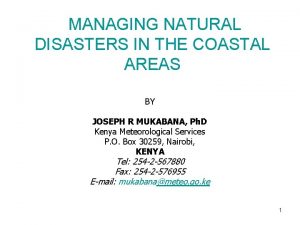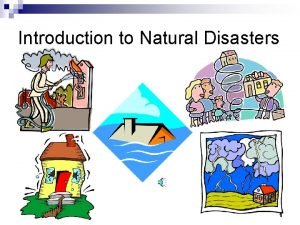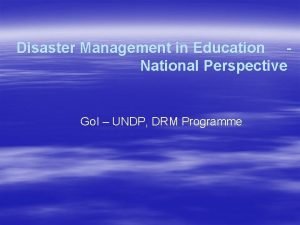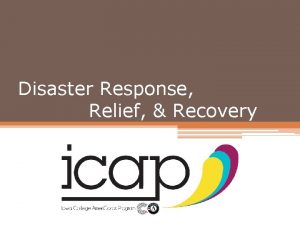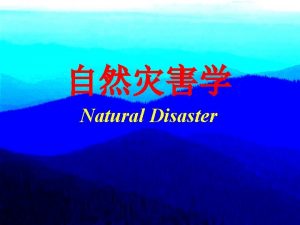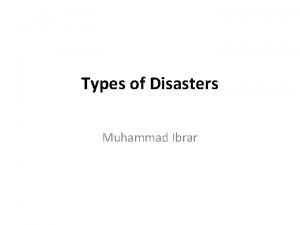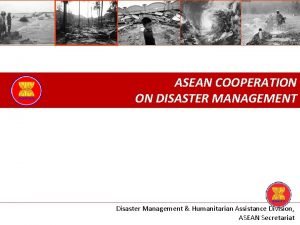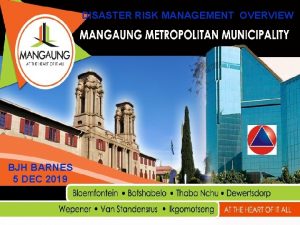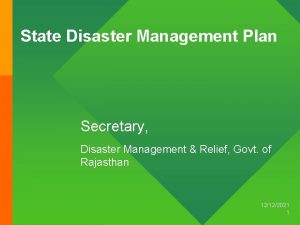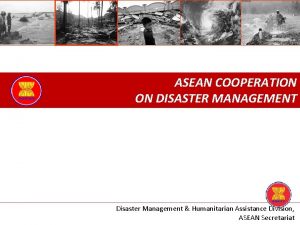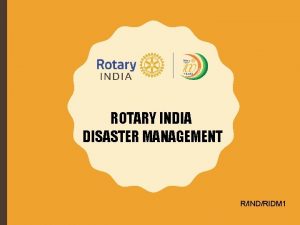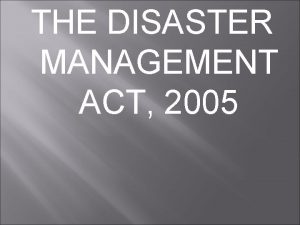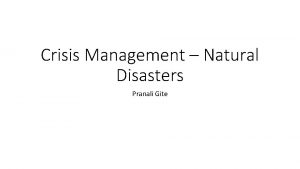Disaster Management Introduction n Disasters have existed ever























- Slides: 23

Disaster Management

Introduction n Disasters have existed ever since the existence of mankind n They result in large number of deaths & injuries n Globally and locally the damage and destruction due to disasters is on the rise

Definition “Any occurrence that causes damage, ecological disruption, loss of human life and deterioration of health and health services on a scale sufficient to warrant an extraordinary response from outside the affected community or area” Source: World Health Organization

Definition: n Destructive event that results in the need for a wide range of emergency resources to assist and ensure the survival of the stricken population. Maxcy-Rosenau-Last

Classification Disasters caused by: n Natural phenomenon n Made Technological Disasters Conflict-related disasters or complex emergencies

Natural Disasters n Meteorological Disasters: Storms (Cyclones. hailstorms, hurricanes, tornadoes, typhoons and snow storms), Cold spells, Heat Waves and Droughts n Typological Disasters: Avalanches, Landslides and Floods

Natural Disasters n Telluric and Teutonic Disasters: Earthquakes, Tsunamis and Volcanic Eruptions n Biological Disasters: Insect Swarms, (e. g. locust) and Epidemics of Communicable Diseases.

Manmade Disasters Civil Disturbances: Riots and Demonstrations n Warfare: 1. Conventional Warfare (bombardment, blockage and siege) 2. Non Conventional Warfare: Nuclear, Biological and Chemical warfare, Guerrilla Warfare including Terrorism n

Manmade Disasters n n n Refugees: Forced movement of large number of people usually across frontiers Accidents: Transportation calamities (land, air and sea), Collapse of building, dams and other structures, mine disasters. Technological failures (e. g. a mishap at a nuclear power station)

Natural Disasters: Indian Scenario n Floods q q n On an average about 9 million hectares are affected by flood every year India accounted for 1/5 th of global deaths due to floods from 1960 to 1980’s Earthquake q 3 % of total area amounting to 3. 3 million sq kilometers vulnerable to seismic activities of varying intensity

Natural Disasters: Indian Scenario n Cyclones q q Long coastline of 5700 kilometers Orissa cyclone in 1982 distressed 7 million people Andhra cyclone in 1997 killed 10, 000 people and 23, 000 cattle Tsunami in 2005 have claimed several thousand lives and buried several villages under watery grave

Man Made Disasters n India suffered the largest manmade disaster in Bhopal on 3 rd December 1984 when chemical gases leaked killing 2500 people

Disaster Cycle Disaster Impact Response Preparedness Risk Reduction Recovery Mitigation Reconstruction Recovery phase Disaster Cycle

Disaster Response n n n Includes measures that are taken immediately prior to, and following disasters Directed towards saving, life and protecting property To deal with the immediate damage caused by the disaster

Triage n n n First come first treated inadequate in mass emergencies Time, personnel and resources are grossly insufficient to meet all the needs Sorting or triage is the only appropriate way Provides maximum benefit to most of the injured Identify those whose progress is most favorable

Categories in Triage n Category I: Immediate Treatment: Severely injured victims who can be saved if they receive appropriate stabilization, transportation and treatment immediately n Category II: Delayed Treatment: Urgent but less serious injuries who can be transported and treated after the most serious have been attended to

Categories in Triage n Category III: Minimal Treatment: Walking wounded who can often be attended in small group and in ambulances n Category IV Injuries: Injuries, which are not serious, will generally be treated and sent back to their homes

Color Coding Red tags indicate first priority n Yellow priority two n Green priority three n Black - Dead n

Relief Phase n n n Epidemiologic surveillance and disease control Vaccination Nutrition

Rehabilitation n n Water Supply Food Safety Basic sanitation and Personal Hygiene Vector Control

Disaster Mitigation n n Measures aimed at reducing the impact of a natural or manmade disaster on a nation or community Ex: Design of Buildings

Disaster Preparedness n n Measures, which enable to respond rapidly and effectively to disaster situations Formulation of viable disaster plans Maintenance of resources and training of personnel Organizing, planning, coordinating

Take Home Message n n n Disasters are a phenomenon by themselves Various unique characteristics which are crucial for disaster management Appropriate planning and early response mitigates damage and saves lives!!
 Ever ancient ever new
Ever ancient ever new Clarified it
Clarified it Ever ancient ever new
Ever ancient ever new Ever tried ever failed no matter
Ever tried ever failed no matter Introduction of natural disasters
Introduction of natural disasters Essay on natural calamities
Essay on natural calamities Man-made disasters introduction
Man-made disasters introduction The ural mountains mark the traditional boundary between
The ural mountains mark the traditional boundary between What types of homes existed in salem
What types of homes existed in salem A cube has 6 faces and 8 vertices
A cube has 6 faces and 8 vertices Pismeni zadatak
Pismeni zadatak Have you ever wondered
Have you ever wondered Facts about shoplifting
Facts about shoplifting Handcuffs
Handcuffs Have you ever experienced culture shock
Have you ever experienced culture shock Have you ever climbed a mountain?
Have you ever climbed a mountain? Chipper chopper joe
Chipper chopper joe Have you ever ridden a camel?
Have you ever ridden a camel? Have you ever climbed a mountain
Have you ever climbed a mountain Have you ever seen a greenhouse
Have you ever seen a greenhouse Have you ever been to hong kong?
Have you ever been to hong kong? Have you ever watched people
Have you ever watched people What are stanzas in a poem
What are stanzas in a poem Have you ever been to disneyland
Have you ever been to disneyland




